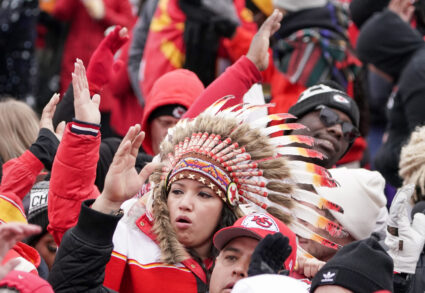
It’s been said that nobody can fully understand the meaning of love unless they've had a dog. Billy Collins agrees,…

KANSAS CITY, Mo. (AP) — Moontee Sinquah spent only one minute onstage inside the Footprint Center in downtown Phoenix during the NFL's Super Bowl Opening Night. But it's a minute that will remain unforgettable.
The Native American hoop dancer had never been that close to football players and coaches about to compete in the league's biggest game. As he and other Indigenous performers sang and danced, they heard elated whoops from Indigenous people in the audience.
It gave Sinquah chills.
"I'm just really grateful that they did highlight our people because I think it's really important," said Sinquah, who is a member of the Hopi-Tewa and Choctaw nations. But when he thinks of that inclusion coupled with Super Bowl cameras panning to Kansas City Chiefs fans doing the maligned "tomahawk chop," Sinquah says that juxtaposition leaves him "perplexed."
"I think that's the only thing that really bothers me about that whole thing is that, and I don't know where it came from. And I don't really fully understand it, but it is almost like a mockery," Sinquah said.
The Super Bowl-winning Kansas City Chiefs embarked on their victory lap Wednesday, with players and fans alike doing the "chop" during a raucous parade and rally. Indigenous people are grappling with the national spotlight once again falling on the team's mascot and fan "war chant" — which they deem racist. This past week in Arizona, where at least a quarter of the land base is tribal reservations, there's been a complicated mix of delight for the NFL involving Native and Indigenous cultures but disdain for those cultures being appropriated.
Fans of the Chiefs long ago adopted the chanting and arm movement symbolizing the brandishing of a tomahawk that began at Florida State University in the 1980s — though the school has an agreement with the Seminole tribe to use the moniker and tribal imagery. In 2020, the Chiefs banned headdresses and war paint in the stadium and pushed for cheerleaders to do the "chop" with a closed fist instead of an open hand.
There were plenty performing the chop in a red sea of fans in Chiefs gear along the parade route and in front of Kansas City's Union Station, where the parade ended. The team then closed out the rally by doing the "chop" in unison in a slurry of confetti.
Andrea Robinson, an 18-year-old psychology major at the University of Kansas, hollered while doing the open-handed chop with the crowd.
"I think we should keep it," Robinson said. "I mean we need to be respectful about it. I understand but I mean it's a tradition."
WATCH: Doug Williams on the significance of 2 Black quarterbacks in the Super Bowl
David Cordray, a 38-year-old heating, cooling and refrigeration technician from Kansas City, Missouri, said he doesn't see the harm in the gesture or the mascot. He also pointed to changes such as the retirement of the live mascot, a horse named "Warpaint" that a cheerleader would ride in the stadium after the team scored. Previously, a man donning a Native headdress rode the horse.
"If they don't think it is OK to do then maybe we should stop. But the Native Americans I've come in contact with have said that they didn't have any issues with it. Basically it is all opinion-based," Cordray said. "We've gone a long way to make sure that we are respectful of everybody's culture and being vigilant about it."
The origin of the Chiefs nickname may have more to do with the mayor who helped lure the franchise from Dallas in 1963 than any connection to Native Americans.
Mayor H. Roe Bartle was a large man known as "The Chief" for his many years of leadership in the Boy Scouts. Team owner Lamar Hunt reportedly named the team the Chiefs in honor of Bartle.
Even the connection with Bartle has undertones that some find offensive. Though he was white, Bartle started the "Mic-O-Say Tribe," a youth camping organization that remains active and continues to use Native American attire and language. Young participants are "braves," and the top leader is the "chief."
Chiefs President Mark Donovan said last week that Bartle obtained permission from the Northern Arapaho Tribe to use the term "chief." Rhonda LeValdo, founder of the Kansas City-based Indigenous activist group Not In Our Honor, disputed that narrative.
READ MORE: Pregnant Rihanna shines bright during Super Bowl 57 halftime show
James Simermeyer, a member of the Coharie Tribe based in North Carolina, watched most of the game from his home in Baltimore. He appreciated the involvement of Sinquah's dance troupe and a University of Arizona student who is Navajo and deaf using Native American sign language during "America the Beautiful" before the game. At the same time, it felt like "one step forward two steps back" when he heard the chant Kansas City fans do during the chop.
With the publicity around the Chiefs' win, Simermeyer said it's like an implicit condoning of all the things Native and Indigenous people find hurtful.
"There's no positive reason to support it. But it just kind of affirms the negative behavior that Kansas City fans are doing," Simermeyer said. "I can't imagine how many other people are out there and having the conversation with their non-Native colleagues about whether or not they're offended by this."
Sustain our coverage of culture, arts and literature.